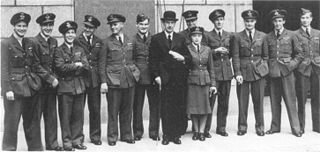
Air Chief Marshal Hugh Caswall Tremenheere Dowding, 1st Baron Dowding, was an officer in the Royal Air Force. He was Air Officer Commanding RAF Fighter Command during the Battle of Britain and is generally credited with playing a crucial role in Britain's defence, and hence, the defeat of Operation Sea Lion, Adolf Hitler's plan to invade Britain.

The Battle of Britain was a military campaign of the Second World War, in which the Royal Air Force (RAF) and the Fleet Air Arm (FAA) of the Royal Navy defended the United Kingdom (UK) against large-scale attacks by Nazi Germany's air force, the Luftwaffe. It was the first major military campaign fought entirely by air forces. The British officially recognise the battle's duration as being from 10 July until 31 October 1940, which overlaps the period of large-scale night attacks known as the Blitz, that lasted from 7 September 1940 to 11 May 1941. German historians do not follow this subdivision and regard the battle as a single campaign lasting from July 1940 to May 1941, including the Blitz.

The Royal Flying Corps (RFC) was the air arm of the British Army before and during the First World War until it merged with the Royal Naval Air Service on 1 April 1918 to form the Royal Air Force. During the early part of the war, the RFC supported the British Army by artillery co-operation and photographic reconnaissance. This work gradually led RFC pilots into aerial battles with German pilots and later in the war included the strafing of enemy infantry and emplacements, the bombing of German military airfields and later the strategic bombing of German industrial and transport facilities.

Marshal of the Royal Air Force Hugh Montague Trenchard, 1st Viscount Trenchard, was a British officer who was instrumental in establishing the Royal Air Force. He has been described as the "Father of the Royal Air Force."
The Big Wing, also known as a Balbo, was an air fighting tactic proposed during the Battle of Britain by 12 Group commander Air Vice-Marshal Trafford Leigh-Mallory and Acting Squadron Leader Douglas Bader. In essence, the tactic involved meeting incoming Luftwaffe bombing raids in strength with a wing-shaped formation of three to five squadrons. In the Battle, this tactic was employed by the Duxford Wing, under Bader's command.

RAF Bentley Priory was a non-flying Royal Air Force station near Stanmore in the London Borough of Harrow. It was the headquarters of Fighter Command in the Battle of Britain and throughout the Second World War. The Royal Air Force station closed its operations on 30 May 2008, with all units relocating to new accommodation at RAF Northolt, a few miles away.

The Few were the airmen of the Royal Air Force (RAF) and the aviators of the Fleet Air Arm, Royal Navy (RN) who fought the Battle of Britain in the Second World War. The term comes from Winston Churchill's phrase "Never, in the field of human conflict, was so much owed by so many to so few." It also alludes to Shakespeare's famous speech in his play, Henry V: "We few, we happy few, we band of brothers..."

Number 16 Squadron Royal Air Force, nicknamed 'the Saints', is a flying squadron of the Royal Air Force (RAF) who currently provide elementary flying training (EFT) with the Grob Tutor T1, presently based at RAF Wittering, an RAF airbase in Cambridgeshire, England.

The Battle of Britain Monument in London is a sculpture on the Victoria Embankment, overlooking the River Thames, which commemorates the individuals who took part in the Battle of Britain during the Second World War.
This article lists the RAF Fighter Command order of battle at 15 September 1940, during the Battle of Britain.

No. 611 Squadron is a British Royal Air Force squadron. It was first formed in 1936 and was disbanded in 1957 after seeing combat as a fighter unit during the Second World War. It was reformed as a reserve squadron in 2013.
Jason Paul Sutton, OBE, is a Royal Air Force Regiment officer who was appointed Officer of the Order of the British Empire for his actions whilst serving in Iraq in 2007.
No. 421 (Reconnaissance) Flight was a specialist RAF fighter flight created on 21 September 1940 to patrol the Channel and provide early warning of the types of incoming Luftwaffe raids from occupied France. It was later expanded to full squadron strength and renumbered as No. 91 Squadron on 11 January 1941. Its role led to its pilots being nicknamed "Jim Crows".
Hubert Raymond Allen, was a Royal Air Force (RAF) officer and commentator on defence matters. He fought during the Battle of Britain and was a flying ace of the Second World War, scoring 8 victories. Following his retirement from the RAF as a wing commander in 1965, Allen wrote several controversial books and articles on air power. He criticised RAF Air Staff policies before and during the Second World War. In contrast to the conventional narrative account, he maintained that during the Battle of Britain naval rather than air power was the crucial factor. His opinions clashed with mainstream opinion of the RAF's role, and with the views of many air historians, but his viewpoint received some support and significant attention.









